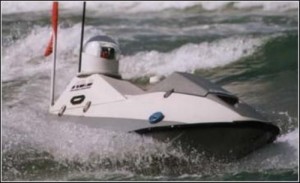 Villanova University and Unmanned Ocean Vehicles, Inc., in the USA have been developing the powertrain and harvesting for an unmanned surface boat using funding from the US Office of Naval Research. In a publication in 2012, it referred to the work as an optimized hybrid power solution for an Unmanned Surface Vehicle USV using a combination of hierarchical and cost function optimization for 24 hours. The paper contributes by developing a unique simplified solution based on modular optimization. It describes hydrodynamic modelling for USV drag-Effective Horse Power requirement, individual power sources modelling and load profile of a MCM USV. The optimized results show the mix of hybrid power can support the dynamic and unpredictable demands of the USV.
Villanova University and Unmanned Ocean Vehicles, Inc., in the USA have been developing the powertrain and harvesting for an unmanned surface boat using funding from the US Office of Naval Research. In a publication in 2012, it referred to the work as an optimized hybrid power solution for an Unmanned Surface Vehicle USV using a combination of hierarchical and cost function optimization for 24 hours. The paper contributes by developing a unique simplified solution based on modular optimization. It describes hydrodynamic modelling for USV drag-Effective Horse Power requirement, individual power sources modelling and load profile of a MCM USV. The optimized results show the mix of hybrid power can support the dynamic and unpredictable demands of the USV.
The natural energy sources (solar array and wave energy converter) are used up to their maximum limits and are also used to charge the battery bank to facilitate long duration Intelligence, Surveillance, Reconnaissance ISR operation of the USV. The system control variables such as charging/discharging battery currents, number of solar panels, flow rate of hydrogen, hydrogen pressure and fuel storage capacity are selected as the optimizing variables for the optimization algorithm. Feasible constraints and upper/lower bounds on system control variables are defined to ensure the smooth running of the optimization algorithm. These constraints and bounds help to provide better control over variables of each power source during real time operation. Additionally, optimized system control variables make the system remain stable in any discrete hour. The scaled-up model results in a mismatch between the power demand and the power generated. In order to resolve this issue, a complete re-optimization of the power system must be performed.
In addition, the Villanova University Autonomous Surface Vehicle ASV team has designed and built a fully autonomous surface vehicle to compete in the Association for Unmanned Vehicles Systems International (AUVSI) and the Office of Navy Research (ONR)’s 5th International Autonomous Surface Vehicle Competition. Using the knowledge and experience of past and present team members, the unmanned surface vehicle has the ability to complete a set of core tasks essential for this competition. It has the ability to navigate a buoy course and complete other tasks such as extinguishing a simulated fire and identifying a hot target. For the 2012 competition, the ASV team has developed a new catamaran style boat that weighs less and can navigate more effectively than the previous model.
Source: Energy Harvesting Journal


















